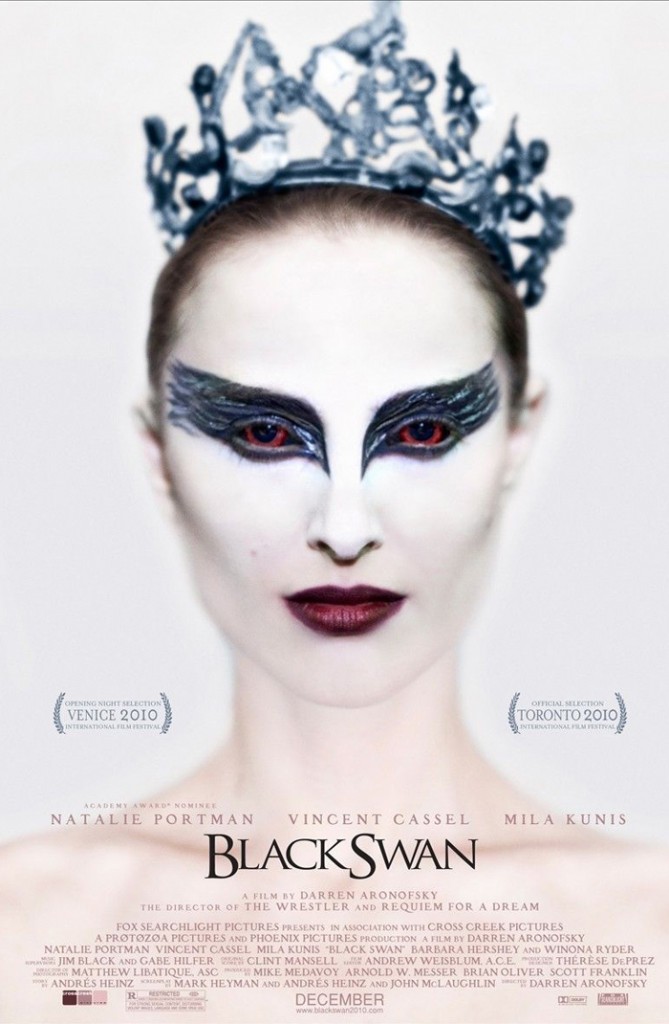When Hollywood decides to depict a specific trade, dramatic license usually trumps veracity. Think all those cop movies truly depict an average day in the life and thinking of a policeman? How about the hilarious world of newspaper hacks in the likes of The Front Page? Black Swan, the new horror film with a ballet backdrop, is no exception. Art Scatter senior correspondent Martha Ullman West argues that if you think this is what the ballet world is really like … well, she can get you a very good deal on a bridge in Brooklyn.
*
By Martha Ullman West
 Black Swan is not a film about ballet.
Black Swan is not a film about ballet.
Oh sure, there are a few shots of point shoes, not to mention bleeding toes, company class, unconvincing rehearsals of small bits of Swan Lake, and Natalie Portman, who richly deserves for her acting (but not her dancing) the Golden Globe award she picked up Sunday night. She spent two years taking ballet classes, and lost a lot of weight for her role.
But here’s the rub. Classical ballet, and director Darren Aronofsky‘s profoundly Puritanical view of the art form, provide the mere framework for a film about a deeply troubled young woman whose cries for help are unheard, or denied, by a mother who thinks only of herself and an employer who seems only to think about sex.
Yes, there are sexually abusive artistic directors in ballet. Yes, some ballet dancers suffer from eating disorders. Yes, there are vicious rivalries between young and older dancers. And yes, the art form itself is extremely hard on the body, and the search for perfection of technique can bend the mind. But I submit that Aronofsky’s film is no more about ballet than All About Eve is about the theater (although, speaking of Bette Davis, it certainly has some elements of Whatever Happened to Baby Jane?).
Most ballet dancers work too hard to have either the time or the energy for prolific sex (Nureyev, notoriously, was one exception). No young dancer about to make her debut in one of the hardest ballerina roles in the canon would go out on the town, as Portman is lured into doing, the night before the first stage rehearsal. But Aronofsky harks back in this film to a time when dancers, including ballet dancers, were thought to be little better than whores, so much so that Isadora Duncan identified herself as an artist, never a dancer.
The only scene in Black Swan that really rang true for me takes place in the beginning, when the company artistic director, played with a combination of suave and slime by Vincent Kassel, kisses Portman in his office and she bites him. Perfect. But that could be any young woman rejecting sexual harassment: Anyone watched Mad Men lately?
In several places I got the giggles. The dialogue is someone’s idea of what happens in the studio, not what really goes on. Kassel keeps addressing the pianist as “Maestro” and asks personal questions, rather than requesting a lift be higher, a port de bras lower, more rounded, less angular, whatever. Some film reviewers — and I make no claims of knowing much about film, by the way — have said Black Swan is a good horror movie. It certainly has enough blood, flowing from every conceivable orifice. But when Portman, now disintegrating into true madness toward the end of the film, hallucinates that she’s murdered her understudy and drags her body around her dressing room, it’s so over the top it’s funny.
The best thing to do with this film is to view it as a cautionary tale — certainly in light of the events in Tucson, when yet again, a young person descending into madness and crying for help caused a tragedy of enormous proportions. In Black Swan, the Portman character’s graphic screams for help are likewise ignored. And Swan Lake becomes a bloodbath.